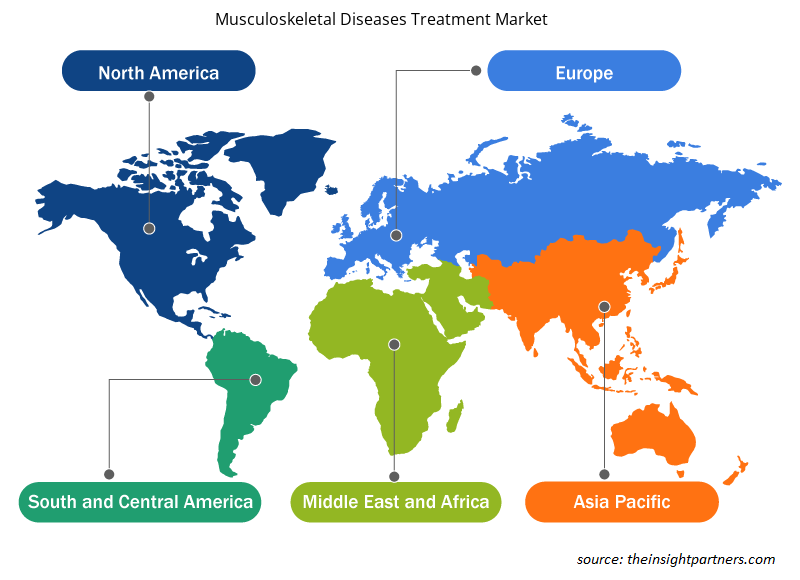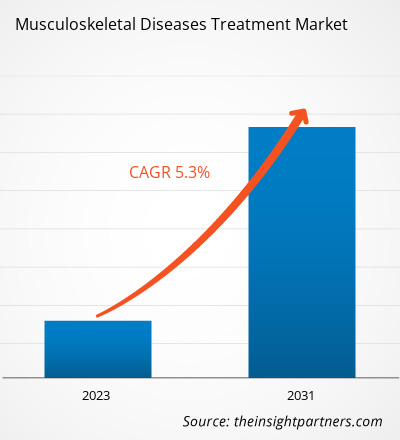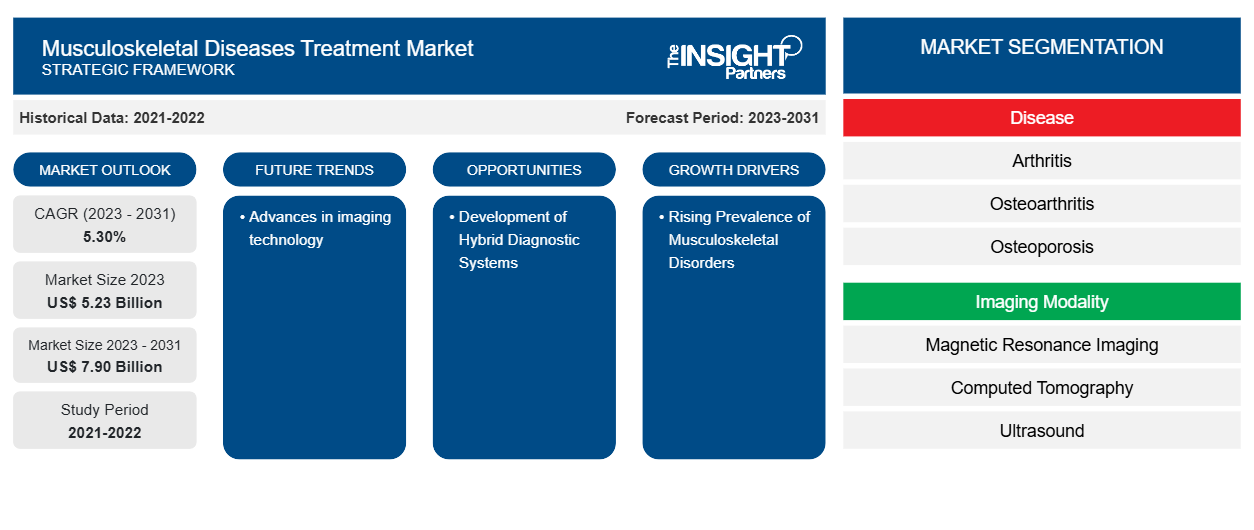Der Markt für die Behandlung von Erkrankungen des Bewegungsapparats soll von 5,23 Milliarden US-Dollar im Jahr 2023 auf 7,90 Milliarden US-Dollar im Jahr 2031 anwachsen. Für den Zeitraum 2023–2031 wird ein durchschnittliches jährliches Wachstum von 5,30 % erwartet. Fortschritte in der Bildgebungstechnologie und zunehmende interventionelle Verfahren werden voraussichtlich weiterhin wichtige Trends auf dem Markt für die Behandlung von Erkrankungen des Bewegungsapparats bleiben.
Marktanalyse zur Behandlung von Erkrankungen des Bewegungsapparats
Muskel-Skelett-Erkrankungen beziehen sich auf die Gruppe von Erkrankungen, die sich negativ auf Muskeln, Gelenke, Knochen und andere menschliche Körperteile auswirken. Sehnenentzündung, Osteoarthritis, Spondylitis und Osteoporose gehören zu den häufigsten Muskel-Skelett-Erkrankungen. Ärzte diagnostizieren Muskel-Skelett-Erkrankungen häufig hauptsächlich auf der Grundlage der Krankengeschichte eines Patienten oder durch Durchführung mehrerer körperlicher Untersuchungen. Schlüsselfaktoren, die den Markt für die Behandlung von Muskel-Skelett-Erkrankungen antreiben, sind die steigende Prävalenz von Muskel-Skelett-Erkrankungen, die zunehmende Überalterung der Bevölkerung und technologische Fortschritte bei der Diagnose von Muskel-Skelett-Erkrankungen. Die hohen Kosten für Diagnosesysteme und die mangelnde Verfügbarkeit von qualifiziertem Fachpersonal behindern jedoch das Wachstum des Marktes.
Marktübersicht zur Behandlung von Erkrankungen des Bewegungsapparats
Nordamerika ist der größte Markt für die Behandlung von Erkrankungen des Bewegungsapparats, wobei die USA den größten regionalen Marktanteil halten, gefolgt von Kanada. Das Marktwachstum in Nordamerika wird durch die steigende Nachfrage nach innovativen Produkten von Ultraschall-, PET-, SPECT- und Magnetresonanztomographie-Unternehmen, die Präsenz wichtiger Marktakteure und umfangreiche F&E-Aktivitäten verschiedener Hochschulen und Forschungsinstitute vorangetrieben. Außerdem tragen der zunehmende Fokus auf den Einsatz fortschrittlicher Methoden im Gesundheitswesen, staatliche und private Initiativen zur Förderung früher Diagnosen und enorme finanzielle Mittel staatlicher und privater Stellen für die Forschung im Bewegungsapparat zur Umsatzgenerierung auf dem nordamerikanischen Markt für die Behandlung von Erkrankungen des Bewegungsapparats bei. Die Umsatzgenerierung und die globale wirtschaftliche Position Nordamerikas auf dem globalen Markt für die Behandlung von Erkrankungen des Bewegungsapparats.
Passen Sie diesen Bericht Ihren Anforderungen an
Sie erhalten kostenlos individuelle Anpassungen an jedem Bericht, einschließlich Teilen dieses Berichts oder einer Analyse auf Länderebene, eines Excel-Datenpakets sowie tolle Angebote und Rabatte für Start-ups und Universitäten.
- Holen Sie sich die wichtigsten Markttrends aus diesem Bericht.Dieses KOSTENLOSE Beispiel umfasst eine Datenanalyse von Markttrends bis hin zu Schätzungen und Prognosen.
Markttreiber und Chancen für die Behandlung von Erkrankungen des Bewegungsapparats
Steigende Prävalenz von Muskel-Skelett-Erkrankungen begünstigt den Markt
Sportverletzungen, Arbeitsunfälle und altersbedingte Funktionsstörungen können Erkrankungen des Bewegungsapparats verursachen. Rückenschmerzen, rheumatoide Arthritis, Osteoarthritis, Osteoporose, septische Arthritis, Gicht, Myasthenia gravis und systemischer Lupus erythematodes (SLE) gehören zu den häufigsten Erkrankungen des Bewegungsapparats. Der Bewegungsapparat umfasst die Diagnose und Behandlung aller akuten und chronischen Erkrankungen, die sich negativ auf den Bewegungsapparat auswirken, einschließlich Knochen, Muskeln, Sehnen, Gelenke und Bänder, sowie die Behandlung nicht-chirurgischer Läsionen des Bewegungsapparats. Fast 300.000 Babys und Kinder sind von Arthritis oder einer rheumatischen Erkrankung betroffen. Die häufigste Art von Arthritis ist Osteoarthritis, von der etwa 31 Millionen Amerikaner betroffen sind. Bis Ende 2040 wird die Zahl der Menschen, bei denen ärztlich diagnostizierte Arthritis diagnostiziert wird, voraussichtlich über 78 Millionen betragen. Die steigende Prävalenz von Erkrankungen des Bewegungsapparats treibt daher das Wachstum des Marktes für die Behandlung dieser Erkrankungen voran.myasthenia gravis, and systemic lupus erythematous (SLE) are among the most common musculoskeletal diseases. The musculoskeletal system is the diagnosis and management of all acute and chronic conditions adversely affecting the musculoskeletal system, including bones, muscles, tendons, joints, and ligaments, and the treatment of non-surgical lesions of the musculoskeletal system. Almost 300,000 babies and children are affected by arthritis or a rheumatic condition. The common type of arthritis is osteoarthritis, which affects ∼31 million Americans. By the end of 2040, number of people expected to have doctor-diagnosed arthritis will be above 78 million. Thus, the rising prevalence of musculoskeletal diseases drives the the musculoskeletal diseases treatment market growth.
Entwicklung hybrider Diagnosesysteme
Hybrid-MRT-Systeme beziehen sich auf komplexe minimalinvasive Bildgebungsverfahren, die zwei Modalitäten kombinieren, um Informationen über die Anatomie und Physiologie des menschlichen Körpers zu liefern. Das MRT kann mit verschiedenen anderen Bildgebungsverfahren kombiniert werden, darunter Computertomographie (CT) und Positronen-Emissions-Tomographie (PET), oder mit einfachen Bildgebungswerkzeugen wie Röntgendurchleuchtung. Die multimodale Bildgebung ist besonders wichtig geworden, da sich moderne Diagnosetechniken auf die molekulare und genetische Ebene konzentrieren. Die Kombination von PET und MRT hat sich im letzten Jahrzehnt in der klinischen und präklinischen Grundlagenforschung als äußerst erfolgreich erwiesen. Diese Hybride werden zunehmend in klinischen Anwendungen eingesetzt, um Einblicke in verschiedene medizinische Zustände, Krankheiten, biologische Wege und therapeutische Beurteilungen zu liefern.
Marktbericht zur Behandlung von Erkrankungen des Bewegungsapparats – Segmentierungsanalyse
Wichtige Segmente, die zur Ableitung der Marktanalyse zur Behandlung von Erkrankungen des Bewegungsapparats beigetragen haben, sind Krankheit und Bildgebungsmodalität.
- Basierend auf der Krankheit ist der Markt für die Behandlung von Erkrankungen des Bewegungsapparats in Arthritis, Osteoarthritis, Osteoporose, Spondylitis und andere unterteilt. Das Arthritis-Segment hatte im Jahr 2023 den größten Marktanteil.
- Nach Bildgebungsmodalität ist der Markt in Magnetresonanztomographie (MRT), Computertomographie (CT), Ultraschall und andere unterteilt. Das Segment Computertomographie (CT) hatte im Jahr 2023 den größten Marktanteil.
Behandlung von Erkrankungen des Bewegungsapparats Marktanteilsanalyse nach Geografie
Der geografische Umfang des Marktberichts zur Behandlung von Erkrankungen des Bewegungsapparats ist hauptsächlich in fünf Regionen unterteilt: Nordamerika, Asien-Pazifik, Europa, Naher Osten und Afrika sowie Süd- und Mittelamerika.
Nordamerika dominiert den Markt für die Behandlung von Erkrankungen des Bewegungsapparats. Für mehrere Millionen Amerikaner wird die Qualität der Gesundheitsversorgung durch die Qualität der in ihrer Region verfügbaren radiologischen Versorgung symbolisiert. Laut der American Society of Radiologic Technologists werden 2023 in den USA jährlich etwa 275 Millionen konventionelle radiologische Eingriffe durchgeführt. Es gibt staatliche Vorschriften, um die passiven Implantate auf Sicherheit und Kompatibilität in der Magnetresonanzumgebung (MR) zu testen und zu kennzeichnen. In den USA sorgt die Division of Radiological Health im Center for Devices and Radiological Health (CDRH) der US Food and Drug Administration (FDA) für die Sicherheit und Wirksamkeit von medizinischen Geräten und die Sicherheit strahlungsemittierender elektronischer Produkte. Darüber hinaus hat die US-Regierung beschlossen, die Kontrolle über Ultraschallgeräte und ähnliche bildgebende Geräte zu verschärfen, um den Missbrauch dieser Geräte zur Geschlechtsauswahl und zu anderen Zwecken zu verhindern.
Regionale Einblicke in den Markt für die Behandlung von Erkrankungen des Bewegungsapparats
Die regionalen Trends und Faktoren, die den Markt für die Behandlung von Erkrankungen des Bewegungsapparats während des Prognosezeitraums beeinflussen, wurden von den Analysten von Insight Partners ausführlich erläutert. In diesem Abschnitt werden auch die Marktsegmente und die Geografie für die Behandlung von Erkrankungen des Bewegungsapparats in Nordamerika, Europa, im asiatisch-pazifischen Raum, im Nahen Osten und Afrika sowie in Süd- und Mittelamerika erörtert.

- Erhalten Sie regionale Daten zum Markt für die Behandlung von Erkrankungen des Bewegungsapparats
Umfang des Marktberichts zur Behandlung von Erkrankungen des Bewegungsapparats
| Berichtsattribut | Details |
|---|---|
| Marktgröße im Jahr 2023 | 5,23 Milliarden US-Dollar |
| Marktgröße bis 2031 | 7,90 Milliarden US-Dollar |
| Globale CAGR (2023 - 2031) | 5,30 % |
| Historische Daten | 2021-2022 |
| Prognosezeitraum | 2023–2031 |
| Abgedeckte Segmente | Nach Krankheit
|
| Abgedeckte Regionen und Länder | Nordamerika
|
| Marktführer und wichtige Unternehmensprofile |
|
Marktteilnehmerdichte bei der Behandlung von Erkrankungen des Bewegungsapparats: Auswirkungen auf die Geschäftsdynamik verstehen
Der Markt für die Behandlung von Erkrankungen des Bewegungsapparats wächst rasant. Dies wird durch die steigende Nachfrage der Endnutzer aufgrund von Faktoren wie sich entwickelnden Verbraucherpräferenzen, technologischen Fortschritten und einem größeren Bewusstsein für die Vorteile des Produkts vorangetrieben. Mit der steigenden Nachfrage erweitern Unternehmen ihr Angebot, entwickeln Innovationen, um die Bedürfnisse der Verbraucher zu erfüllen, und nutzen neue Trends, was das Marktwachstum weiter ankurbelt.
Die Marktteilnehmerdichte bezieht sich auf die Verteilung der Firmen oder Unternehmen, die in einem bestimmten Markt oder einer bestimmten Branche tätig sind. Sie gibt an, wie viele Wettbewerber (Marktteilnehmer) in einem bestimmten Marktraum im Verhältnis zu seiner Größe oder seinem gesamten Marktwert präsent sind.
Die wichtigsten Unternehmen auf dem Markt für die Behandlung von Erkrankungen des Bewegungsapparats sind:
- ALLGEMEINE ELEKTRIK
- KONINKLIJKE PHILIPS NV
- SIEMENS AG
- CANON MEDICAL SYSTEMS CORPORATION
- Hitachi, Ltd
- Accuray Incorporated
Haftungsausschluss : Die oben aufgeführten Unternehmen sind nicht in einer bestimmten Reihenfolge aufgeführt.

- Überblick über die wichtigsten Akteure auf dem Markt für die Behandlung von Erkrankungen des Bewegungsapparats
Marktnachrichten und aktuelle Entwicklungen zur Behandlung von Erkrankungen des Bewegungsapparats
Der Markt für die Behandlung von Erkrankungen des Bewegungsapparats wird durch die Erhebung qualitativer und quantitativer Daten nach Primär- und Sekundärforschung bewertet, die wichtige Unternehmensveröffentlichungen, Verbandsdaten und Datenbanken umfasst. Nachfolgend sind einige der Entwicklungen auf dem Markt für die Behandlung von Erkrankungen des Bewegungsapparats aufgeführt:
- Solera Health hat sein neues Angebot für den Bewegungsapparat (MSK) über erstklassige digitale MSK-Therapielösungen auf den Markt gebracht – SWORD Health, Kaia Health und Sworkit. Das Unternehmen gibt an, dass sein neues MSK-Angebot ein Kontinuum von Erkrankungen des Bewegungsapparats durch subklinische Dienstleistungen abdecken wird, die präventives Wohlbefinden, Verletzungs- und chronisches Krankheitsmanagement sowie präoperative und postoperative Rehabilitation über sein wachsendes Netzwerk erstklassiger, evidenzbasierter digitaler Interventionen umfassen. (Quelle: Solera Health, Pressemitteilung, 2021)
Marktbericht zur Behandlung von Erkrankungen des Bewegungsapparats – Umfang und Ergebnisse
Der Bericht „Marktgröße und Prognose zur Behandlung von Erkrankungen des Bewegungsapparats (2021–2031)“ bietet eine detaillierte Analyse des Marktes, die die folgenden Bereiche abdeckt:
- Marktgröße und Prognose zur Behandlung von Erkrankungen des Bewegungsapparats auf globaler, regionaler und Länderebene für alle wichtigen Marktsegmente, die im Rahmen des Berichts abgedeckt sind
- Markttrends und Marktdynamiken im Bereich der Behandlung von Erkrankungen des Bewegungsapparats, wie Treiber, Beschränkungen und wichtige Chancen
- Detaillierte PEST/Porters Five Forces- und SWOT-Analyse
- Marktanalyse zur Behandlung von Erkrankungen des Bewegungsapparats, die wichtige Markttrends, globale und regionale Rahmenbedingungen, wichtige Akteure, Vorschriften und aktuelle Marktentwicklungen umfasst
- Branchenlandschaft und Wettbewerbsanalyse, die die Marktkonzentration, Heatmap-Analyse, prominente Akteure und aktuelle Entwicklungen auf dem Markt für die Behandlung von Erkrankungen des Bewegungsapparats umfasst
- Detaillierte Firmenprofile
- Historische Analyse (2 Jahre), Basisjahr, Prognose (7 Jahre) mit CAGR
- PEST- und SWOT-Analyse
- Marktgröße Wert/Volumen – Global, Regional, Land
- Branchen- und Wettbewerbslandschaft
- Excel-Datensatz
Aktuelle Berichte
Erfahrungsberichte
Grund zum Kauf
- Fundierte Entscheidungsfindung
- Marktdynamik verstehen
- Wettbewerbsanalyse
- Kundeneinblicke
- Marktprognosen
- Risikominimierung
- Strategische Planung
- Investitionsbegründung
- Identifizierung neuer Märkte
- Verbesserung von Marketingstrategien
- Steigerung der Betriebseffizienz
- Anpassung an regulatorische Trends





















 Kostenlose Probe anfordern für - Markt für die Behandlung von Erkrankungen des Bewegungsapparates
Kostenlose Probe anfordern für - Markt für die Behandlung von Erkrankungen des Bewegungsapparates